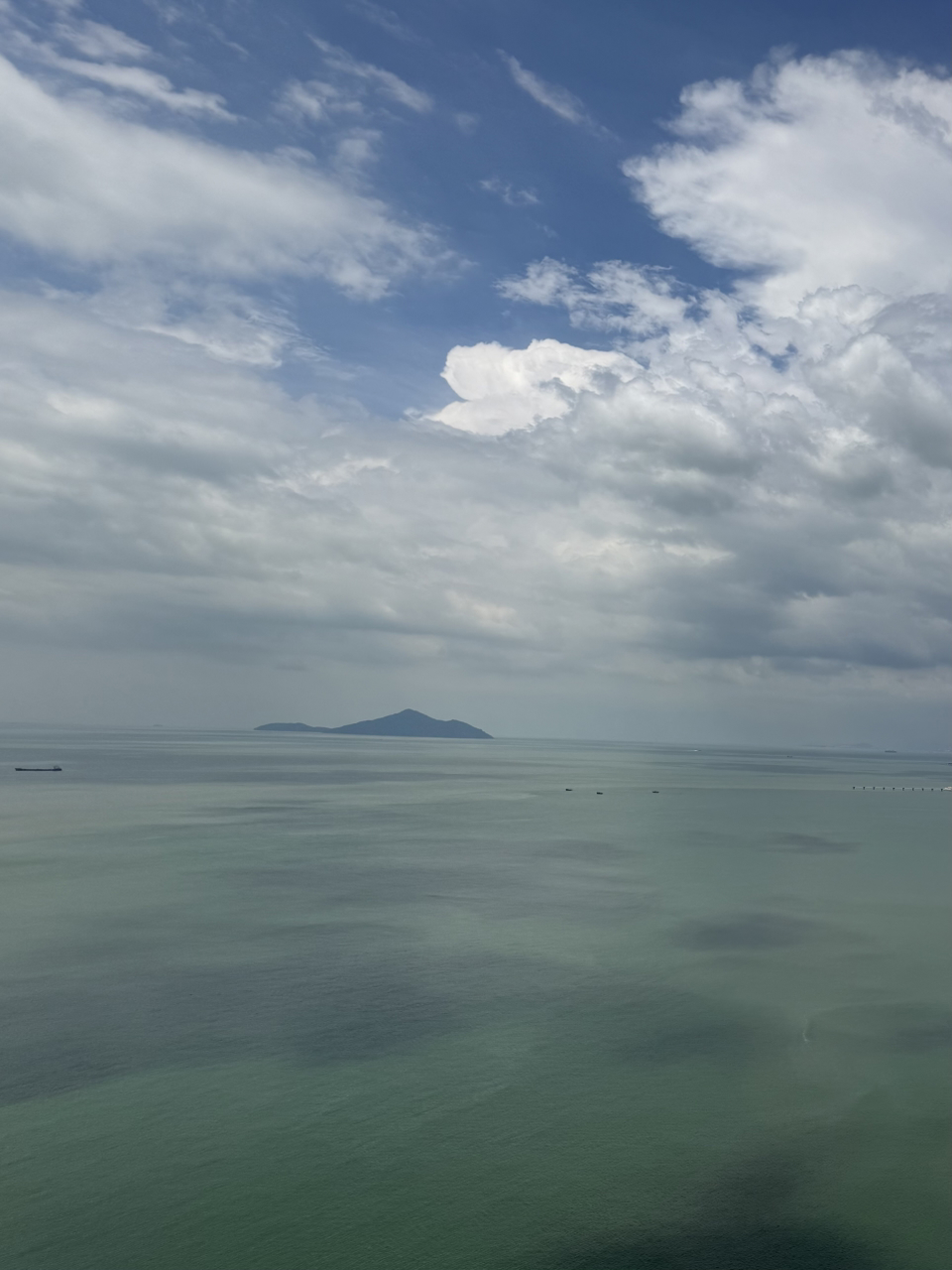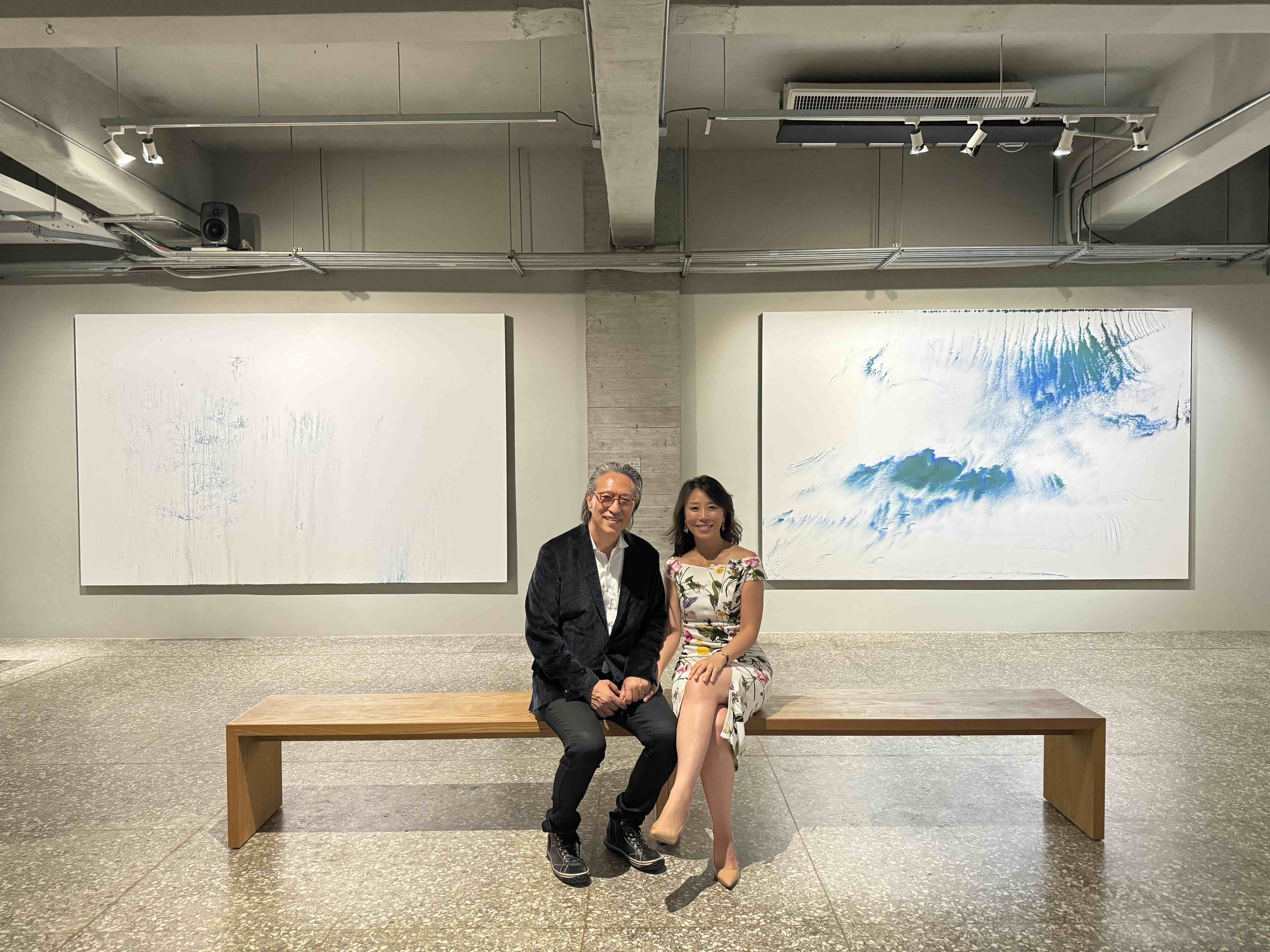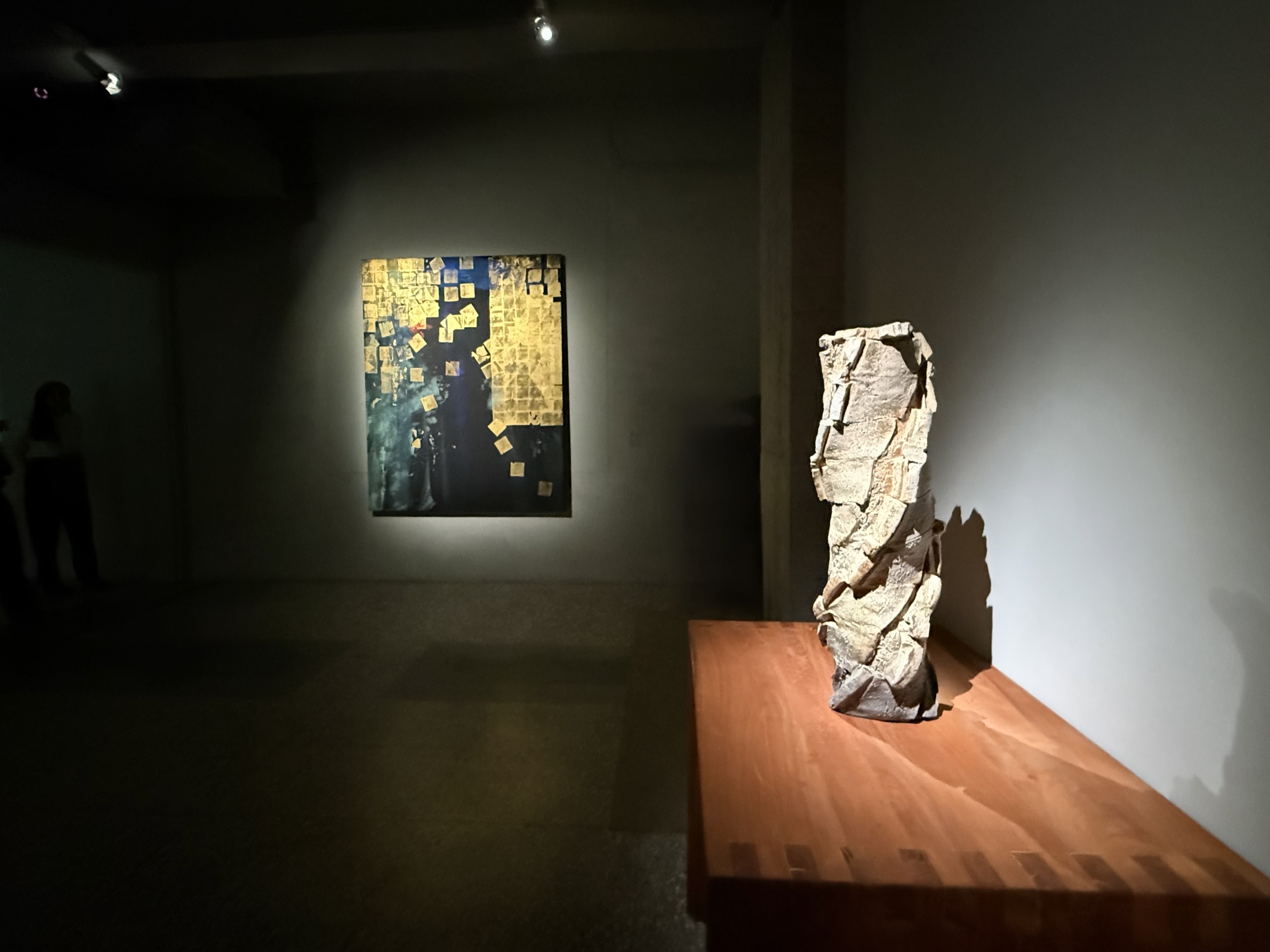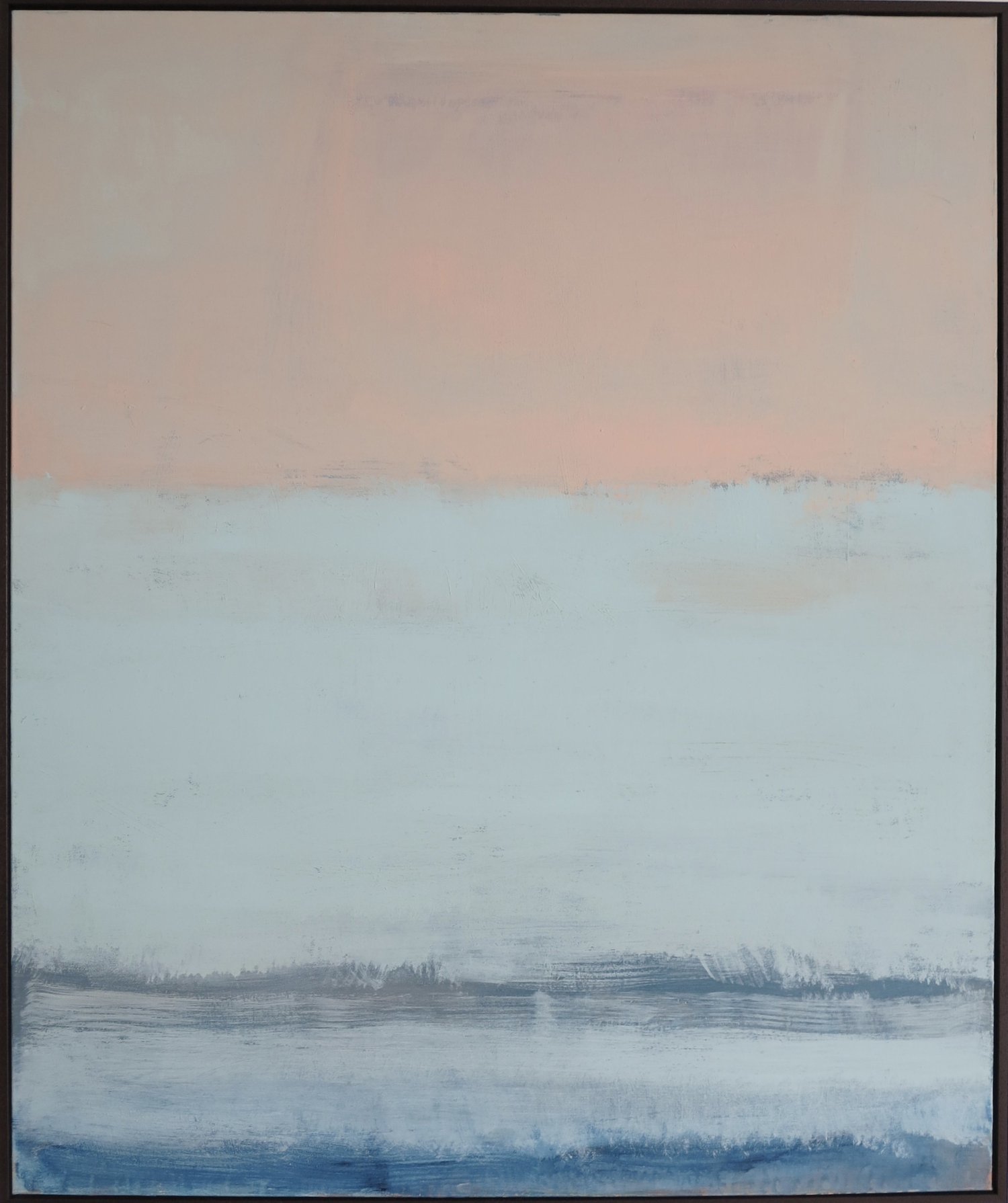“Art is awareness”
– Makoto Fujimura
Heading image: Quiet Waters, mixed media on canvas, 100 x 120 cm. Copyright © 2025 Jon White, courtesy of the artist.
A Note from IAMCultureCare
Like most of us these days — willingly or not — I’ve recently found myself thinking a lot about artificial intelligence. Anyone who has used ChatGPT or other large language and image models knows that AI has impressive powers with real, if limited, potential benefits. I’ve done more with Microsoft Excel after 20 minutes with a chatbot than I have in many years and tutorials prior, and I’ve enjoyed making homemade desserts armed with a ChatGPT recipe, a cheap ice cream maker, and the ingredients in my fridge. The drawbacks are very real too, and our media feeds are full of competing visions for the future of tech, culture, and our place in a world where deepfake AI-generated videos are now indistinguishable from reality. In practical terms, though, it’s a Pandora’s box. There is no going back to a pre-AI state, and I’m not convinced that an off-grid Luddism is a long term answer, even if I agree with voices like Paul Kingsnorth’s that the net result of all this is a worsening of human life. Our lot now is merely to wade through the mire with some attempt at nuance and a commitment to human dignity.
Yet of all the recent reactions to AI, the one thing I haven’t seen is anyone genuinely claiming that AI art or writing is “beautiful”. AI portraits may be attractive, its writing streamlined and grammatically perfect, chatbot relationships real enough to prompt strong emotional connections, but for all that artificial intelligence offers there is no brush with real transcendence. In my “conversations” with ChatGPT, niceties such as “What a beautiful idea”, or “That’s a profound question” — actual responses I’ve received — ring hollow. We instinctively recognize that AI cannot comprehend beauty. It is merely playacting.
Beauty is, paradoxically, both objective and subjective, and both are innately beyond AI’s abilities. Its objectivity lies in its external universality, that even though its particular attributes may not be universally agreed-upon, the common human experience of beauty does seem to universally de-center the viewer, breaking in from the outside with a transcendence that reorients our entire being. The ego is de-throned. AI, for all its reasoning power, cannot unplug itself and still live. It’s a wonder that we are able to do so.
Beauty is also subjective. It requires an individual human consciousness, with real intelligence, to perceive it. Is an awe-inspiring mountain vista beautiful regardless of whether anyone is there to notice it? On the surface, we might say yes. After all, its material existence (and any attractive qualities which prompt the sense of beauty in the first place) does not change before and after the mountain climber summits the peak and looks out. And yet at the same time, our perception — our attention — brings it into existence, revealing it as if for the first time. The view was there, but in some sense it was not beautiful until the climber experienced it. (By the way, in the Genesis creation account God is as much a viewer as a creator: “And God saw that it was good.”) Everything we can tell from science, religion, and even basic intuition suggests that beauty is something that only we — intelligent consciousnesses made in the Imago Dei—can comprehend. Beauty really is in the eye of the beholder.
Yet although AI may not be able to comprehend beauty, is it possible that it can (or could) create beauty for us to experience? Will AI art, like the controversial AI-generated actress Tilly Norwood currently making headlines, someday produce a beautiful film? Proponents claim AI is merely a tool in the 21st-century artist’s ever-expanding toolbox, that it can be used to make creative processes easier, quicker, more accessible. On the other side, many arguments against its use come from a fearful yet equally utilitarian place: “We are losing our ability to focus”, or “No one knows how to write an email anymore”, or “AI will put people out of a job.” In other words, using AI to create will make us worse at producing things.
Both the hopes and fears have truth in them, but utilitarian arguments for or against AI miss the point: the act of bringing beauty into being (“co-creation”, in Mako’s Theology of Making) requires some effort, some sacrificial labor, by the artist. A painter may use tools of brush and palette and with them create a beautiful painting; but she still has to do the act of making whether she uses a paintbrush or a pencil, and the beauty of the finished artwork is in part an acknowledgment of her skill and labor against some set of creative or physical restraints. Artistic genius strikes not in spite of creative boundaries — a chosen rhyme scheme or meter, the gulf between a blank canvas and the artist’s vision, a singer’s unique vocal anatomy rubbing up against the demands of a musical score — but because of them. It’s in this real-life, somatic act of making that beauty is birthed.
Simone Weil writes about experiencing beauty in both joy and suffering: “Through joy, the beauty of the world penetrates our soul. Through suffering it penetrates our body.” (“The Love of God and Affliction” in Waiting for God). Joy is easily understood: it is the beautiful mountain vista. But how does suffering relate? Weil’s discussion here is in the context of labor, of practicing a trade, of the pain and weariness resulting from a hard-day’s work. AI circumvents this whole process to get at the end-result without the need for the sacrifice of creative effort. The finished product becomes the telos, the ultimate end. AI short-circuits the very process by which beauty is made manifest, and while it increasingly can generate something that appears indistinguishable from the human-made art on the surface, something meaningful is missing. I suspect no AI content will ultimately last.
Let me be clear that I am not saying that those with an inability to work live less meaningful, beautiful lives. In fact, I’ve intentionally been using “labor” rather than “work” because I think it gets closer to Weil’s sense of suffering in a creative effort without all of the industrial-complex, mechanistic connotations — and because of labor’s connections with birth and bringing life into the world. What I am saying is that to pursue beauty is to reject efficiency (and in that sense, I wonder if those with disability may in fact be better-tuned to beauty’s call than those without the need to slow down). The technocratic vision fueling the AI craze — where human beings no longer need to work, all suffering is ended, and there is only pleasure and efficiency — may be utopia for some, but it certainly isn’t Eden. Even in paradise a fulfilled human life involves labor: animal husbandry and gardening can’t be done just sitting around, after all.
So, the AI revolution is here. Yet no matter what this future holds, I do think that an acknowledgment of AI’s innate inability to either comprehend or create beauty is an important part of our individual and cultural response. This month’s featured artist, Jon White, offers one such response, encouraging AI as “Artistic Imagination” rather than “Artificial Intelligence”. To care for culture is to cultivate those things which promote a meaningful, flourishing human life — things like beauty, imagination, and creative labor. A beautiful artwork or essay can’t be generated any more than a mountain can. It takes time, effort, and deep attention, and the feast needs much preparation. So let us continue making, freed from artificially-induced anxieties, knowing that the realm of beauty is still a uniquely human endeavor.
Please do get in touch if this strikes a chord or if you have anything to add to the conversation! We’re all in this AI thing together, figuring it out as we go, and I’d love to hear from you.
Jacob Beaird, Editor
A Note from Mako Fujimura

We landed on the emerald seas of Hong Kong at the beginning of our long Asia trip. After a delightful gathering of collectors in Hong Kong, and a lecture at Hong Kong University (“On the Spiritual in Art”), we headed to Kaohsiung, Taiwan for the opening of my exhibit at Alien (pronounced ã‑lian) Museum (more details below under “Culture Care Events”). We were chased by a hurricane as we were flying out of Hong Kong, which did quite a lot of damage in southern Taiwan. But throughout, we felt we were in the “eye of the storm”, and God protected us and our efforts. There are significant culture care communities in both Hong Kong and Taiwan, and I look forward to reporting more in the days to come.

Walking on Water – Grace & Waves, Azurite on stretched canvas, 84 x 132 in. each panel. Copyright © 2019 Makoto Fujimura.
Alien Art Centre Museum and its wonderful owners Yaman Shan and Jenny Lee (a true culture care curator) paired my work with that of the Japanese ceramicist Shozo Michikawa. His works are literally born out of volcanic ashes, their twisting forms arising like a phoenix with sinews of ash-clay. In a pristine museum space that used to be a military compound for soldiers awaiting deployment, the works resonated peace and invited visitors to behold the curation. The opening also featured a piece by Ravel played on a Steinway piano.
So our feast continues. Art is a feast and collaboration. My exhibits afford me an opportunity to befriend culture care sojourners such as Michikawa san, Jenny and Yaman. My work Walking on Water next to Michikawa san’s bone white ceramic presence sang their grace in waves. Our exhibit became a “still point in a turning world” (T.S. Eliot).
Mako Fujimura

Soliloquies – Joy, mineral pigments and gold on Belgium linen, 80 x 64 in. Copyright © 2009 Makoto Fujimura.
Artist Profile: Jon White

(L‑R): Living Waters No.1 and Living Waters No.4, mixed media on artist board, 20.5 x 20.5 cm, framed size 36 x 36 cm. Copyright © 2025 Jon White.
Since 2021 I’ve been working on a series of smaller, contemplative paintings under the title “Windows To The Sea.” The vision behind this ever growing series is inspired both by my love of the sea and its ability to make me to look up and outward as well as a curiosity around the theology of iconography. The paintings are an invitation to not just look at the painting itself but “see beyond” the piece — like opening up a window into a new reality. The work itself explores a sense of memory, nostalgia, mystery and ultimately longing for new creation. The double frame is an important element in this, hopefully acting as a window itself. My latest Windows To The Sea collection is a 4 piece series titled “Living Waters”.

The Near Horizon, mixed media on canvas, 120 x 100 cm. Copyright © 2025 Jon White.
Jon White is a painter from Cornwall in the UK striving to paint contemporary seascapes that reflect an inner landscape. His work is an invitation to step into a quieter and often more contemplative way of seeing art.
Jon is also the founder and director of Atelier, a creative community with a vision to cultivate beauty and deepen faith in both church and culture. With a strong emphasis on supporting young adults, Atelier’s main expression is a 10-day retreat in Normandy, France that explores rhythms of prayer, worship and making at the intersection of spiritual formation and participants’ own creative offerings. In 2026 Atelier is moving towards a UK expression (in addition to France) that will outwork its vision through residential retreats, one-off events, and resources towards something of a modern monastic lifestyle of prayer and making. For Jon, culture care is at the heart of Atelier as well as his own artistic career.
Culture Care Events & Announcements
- LAST CHANCE: “Into the Silence: Winter into Spring” Exhibition—Boston, MA, Now-October 15. Mako Fujimura and Bruce Herman exhibit original works from the QU4RTETS project alongside newer works by Fujimura in a special exhibit in Gordon College’s Barrington Center for the Arts.
- “Dust and Gold — Makoto Fujimura & Shozo Michikawa” Exhibition—ALIEN ART CENTRE, Taiwan, September 28, 2025-August 30, 2026. Major works by Mako Fujimura are exhibited in poetic dialogue with sculptor Shozo Michikawa in an expansive two-part exhibit — each part lasting six months — reflecting on time and impermanence. The Luminous Chapter invites viewers to explore the question“How is light born?”, and to discover the potential for healing and renewal. The Formative Chapter asks“How does force take shape?”, guiding viewers to explore the gestures behind the works and how time leaves its mark.
- Makoto Fujimura: Art Is: A Journey Into the Light to be published October 21. “Luminous…an impassioned artistic manifesto” (Publisher’s Weekly)…Mako’s next book with Yale University Press will be available this month wherever books are sold (pre-order from the link above). Art Is takes readers along on Mako’s meandering journey as an artist. We witness him making his“process-driven slow art” — using pulverized minerals, gold, or pigments made from oyster shell — as he considers the plants and wildlife on the land where he lives, including further reflections on tree swallows! Bringing together the author’s written reflections with over 70 of his paintings, drawings, and photographs in full color, Art Is invites us to see the world in prismatic and diverse lights, helping us navigate the fractured, divisive times we live in.
- “The Transformative Power of Going Deep”: Makoto Fujimura at the Boston Book Festival — Boston, MA, October 25 @ 10:45AM. Mako Fujimura will speak on his book Art Is: A Journey into the Light at the Boston Book Festival. The panel session is free and open to the public, and will be followed by a book signing.
- “Art Is: A Journey Into the Light—What An Artist Sees” Lecture & Book Signing — Yale University, New Haven, CT, November 17 @ 5:30PM. Mako Fujimura in conversation with poet and essayist Christian Wiman about Fujimura’s book Art Is. Mako will speak about his writing and painting process based in his Princeton Studio. This free and open event is sponsored by the Yale Institute of Sacred Music Literature & Spirituality Program.
- “To See A World in a Grain of Sand” Retreat with Makoto Fujimura — Princeton, NJ, Dec 12 – 14. Goldenwood Institute’s “Dean of Nature” Makoto Fujimura leads a reflective retreat exploring the creative process and the power of attentiveness through the lens of his latest book, Art Is. Drawing on the insight of poet William Blake, retreat participants will consider how the natural world can awaken the senses — inviting us to “see the world in a grain of sand.” This gathering is for anyone longing to see more clearly and listen more deeply in a world full of noise. Registration closes on November 7 or once capacity is reached.
- Windrider Summit at Sundance — Park City, UT, January 25 – 30. Join the Windrider Institute in its annual Summit at the Sundance Film Festival. The Windrider Summit is a one-of-a-kind cultural experience. It is an opportunity to attend the premiere festival for independent films and interact with a community who shares a belief in the transformative power of story. It is also a chance to bring a distinctively spiritual and theological lens to film and explore some of the most important topics in our culture. Register for the Summit at the link above.
- Culture Care: Reconnecting with Beauty for our Common Life 2nd edition to be published July, 2026. The second edition of Mako Fujimura’s original Culture Care thesis is revised and expanded, featuring additional chapters on generative thinking and Culture Care as public theology, a new introduction, foreword by acclaimed journalist David Brooks, afterword by President Emeritus of Fuller Theological Seminary Mark Labberton, and fresh insights and stories of Culture Care in action from the years since the original 2017 publication. Culture Care is available for pre-order now from IVPress at the link above.
Do you have a news item or upcoming culture care event? Consider sharing it with us for a possible feature here in the newsletter! Email jacob@internationalartsmovement.org.
Web Links
- Inkwell interviews Marilynn Robinson, on reading.
- Dissecting a Kipling poem.
- New music recs: Jacob Collier’s “The Light For Days” is a stripped-back, intimate recording featuring his latest work on 5‑string guitar, but it’s as inventive and genre-defying as ever; countertenor Reginald Mobley sings English lute songs in his sophomore solo album “Solitude”; Sierra Hull’s foot-stomping bluegrass mandolin and songwriting is spectacular in “A Tip Toe High Wire”.
- The Public Domain Review features a 19th-century Thai treatise on cats.
- The Hedgehog Review, well, reviews four books on the promises of AI.
- Hannah Rose Thomas’s new portraits of Serbian genocide survivors, in Plough.
- Also from Plough, an interview with Yale University’s Carlos Eire on miracles.
- Andy Patton interviews author and artist John Hendrix for Rabbit Room.
- I’ve never seen anyone more excited for a birthday than Arvo Pärt, who turned 90 this year.
IAMCultureCare is a registered 501c(3) non-profit organization that relies on your support to continue our Culture Care efforts of amending the soil of culture as an antidote to toxic culture wars. This newsletter and our other programming do that effectively, and we welcome gifts of any size to continue these efforts. You can donate online or get in touch with us about corporate sponsorship and other giving methods!
All content in this newsletter belongs to the respective creators, as noted, and is used with permission. If you would like to submit something for consideration in a future newsletter issue, you may do so by filling out this form or by emailing jacob@internationalartsmovement.org.
